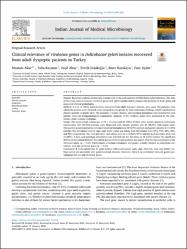| dc.contributor.author | Akar, Mustafa | |
| dc.contributor.author | Kayman, Tuba | |
| dc.contributor.author | Abay, Seçil | |
| dc.contributor.author | Solakoğlu, Tevfik | |
| dc.contributor.author | Karakaya, Emre | |
| dc.contributor.author | Aydın, Fuat | |
| dc.date.accessioned | 2023-04-20T08:01:18Z | |
| dc.date.available | 2023-04-20T08:01:18Z | |
| dc.date.issued | 2022 | |
| dc.identifier.issn | 0255-0857 | |
| dc.identifier.issn | 1998-3646 | |
| dc.identifier.uri | https://doi.org/10.1016/j.ijmmb.2021.12.018 | |
| dc.identifier.uri | https://hdl.handle.net/20.500.11776/10853 | |
| dc.description.abstract | Purpose: Bacterial virulence factors play a major role in the pathogenesis of Helicobacter pylori infection. The aims of this study were to evaluate virulence genes in H. pylori isolates and to compare the presence of these genes and associated clinical pathologies. Methods: A total of 148 H. pylori isolates, recovered from adult dyspeptic patients, were used. The patients, from whom the isolates were obtained, were assigned to two groups by their endoscopic findings, which manifested as chronic gastritis or peptic ulcer. The presence of gastric atrophy and intestinal metaplasia was recorded for each patient, based on histopathological examination. Analyses of the virulence genes were performed by the polymerase chain reaction technique. Results: The patients had a mean age of 47 ?? 15 years and 86 (58%) of them were female. Based on endoscopic examination, 103 (69.6%) patients were diagnosed with chronic gastritis and 45 (30.4%) with peptic ulcer. Histopathological examination revealed intestinal metaplasia in 30 (20%) patients and gastric atrophy in 12 (8%) patients. The prevalence rates of cagA, cagE, iceA1, iceA2, and babA2 were determined to be 87%, 74%, 58%, 26%, and 95%, respectively. The most prevalent vacA alleles were s1/s1a (82%/97%) and the least prevalent allele was s2 (20%). A new vacA genotype (s1as1bs1c) was detected, for the first time, in 18 (12%) isolates. No significant difference was found between the patient groups with chronic gastritis and peptic ulcer for the prevalences of the virulence genes (p > 0.05). Furthermore, intestinal metaplasia and gastric atrophy showed no significant correlation with the virulence genes (p > 0.05). Conclusions: It is thoughted that H. pylori isolates with predominant cagA, cagE, VacA (s1, s1a), and babA2 virulence genes are associated with gastroduodenal diseases. However, there is no correlation between gastric premalignant lesions and virulence genes. | en_US |
| dc.language.iso | eng | en_US |
| dc.publisher | Elsevier | en_US |
| dc.identifier.doi | 10.1016/j.ijmmb.2021.12.018 | |
| dc.rights | info:eu-repo/semantics/openAccess | en_US |
| dc.subject | Chronic Gastritis | en_US |
| dc.subject | Dyspepsia | en_US |
| dc.subject | Helicobacter Pylori | en_US |
| dc.subject | Turkey | en_US |
| dc.subject | Virulence Genes | en_US |
| dc.subject | Baba2 Genotypes | en_US |
| dc.subject | Gastroduodenal Diseases | en_US |
| dc.subject | Vaca Genotypes | en_US |
| dc.subject | Peptic-Ulcer | en_US |
| dc.subject | Cagpai Genes | en_US |
| dc.subject | Caga | en_US |
| dc.subject | Icea | en_US |
| dc.subject | Association | en_US |
| dc.subject | Prevalence | en_US |
| dc.subject | Pathogenesis | en_US |
| dc.title | Clinical relevance of virulence genes in Helicobacter pylori isolates recovered from adult dyspeptic patients in Turkey | en_US |
| dc.type | article | en_US |
| dc.relation.ispartof | Indian Journal of Medical Microbiology | en_US |
| dc.department | Fakülteler, Tıp Fakültesi, Dahili Tıp Bilimleri Bölümü, İç Hastalıkları Ana Bilim Dalı | en_US |
| dc.authorid | AYDIN, Fuat/0000-0002-5467-011X | |
| dc.authorid | Karakaya, Emre/0000-0003-2390-6190 | |
| dc.authorid | Akar, Mustafa/0000-0002-5589-2849 | |
| dc.authorid | ABAY, Secil/0000-0001-5599-7539 | |
| dc.identifier.volume | 40 | en_US |
| dc.identifier.issue | 2 | en_US |
| dc.identifier.startpage | 258 | en_US |
| dc.identifier.endpage | 262 | en_US |
| dc.institutionauthor | Solakoğlu, Tevfik | |
| dc.relation.publicationcategory | Makale - Uluslararası Hakemli Dergi - Kurum Öğretim Elemanı | en_US |
| dc.authorwosid | Akar, Mustafa/GSM-7072-2022 | |
| dc.identifier.wos | WOS:000798871200018 | en_US |
| dc.identifier.scopus | 2-s2.0-85122632477 | en_US |
| dc.identifier.pmid | 35031156 | en_US |



















